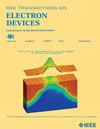Spectrum Continuously Tunable White LED Based on Bilayer Thickness-Graded Quantum Dots
IF 2.9
2区 工程技术
Q2 ENGINEERING, ELECTRICAL & ELECTRONIC
引用次数: 0
Abstract
Regulating the emission spectrum of white light-emitting diode (WLED) is crucial for enhancing lighting quality and advancing smart lighting technology. This study proposes a device to achieve continuous tunability of the multicolor emission spectrum by designing a bilayer cadmium selenide (CdSe)-based quantum-dot (QD) light-conversion structure and the corresponding illuminating control system. Spectral modulation is achieved by a three-pronged approach: 1) the fabrication of the thickness-graded QD film; 2) preassembly monochromatic spectra characterization and spectral optimization; and 3) postassembly mechanical control of a push rod connected to the blue LED chip. Compared to others, the proposed approach provides precise control over continuous spectra modulation in both simulation and experimental settings using just two parameters: driving voltage and blue LED chip position. This device offers a wide range of options for correlated color temperature (CCT) ranging from approximately 2000–60 000 K and illuminance from approximately 0–200 lx. Furthermore, the detailed study of light modulation offers viable approaches for realizing tunable WLEDs in smart lighting and Internet of Things (IoT) systems.基于双层厚度梯度量子点的光谱连续可调谐白光LED
调节白光发光二极管(WLED)的发射光谱对于提高照明质量和推进智能照明技术至关重要。本研究通过设计基于双层硒化镉(CdSe)的量子点(QD)光转换结构和相应的照明控制系统,提出了一种实现多色发射光谱连续可调的装置。光谱调制是通过三管齐下的方法实现的:1)制造厚度梯度的量子点薄膜;2)预组装单色光谱表征及光谱优化;3)连接到蓝色LED芯片的推杆的装配后机械控制。与其他方法相比,所提出的方法在模拟和实验设置中提供了对连续光谱调制的精确控制,只需两个参数:驱动电压和蓝色LED芯片位置。该器件提供了广泛的相关色温(CCT)选项,范围约为2000 - 60000 K,照度约为0-200 lx。此外,光调制的详细研究为在智能照明和物联网(IoT)系统中实现可调谐wled提供了可行的方法。
本文章由计算机程序翻译,如有差异,请以英文原文为准。
求助全文
约1分钟内获得全文
求助全文
来源期刊

IEEE Transactions on Electron Devices
工程技术-工程:电子与电气
CiteScore
5.80
自引率
16.10%
发文量
937
审稿时长
3.8 months
期刊介绍:
IEEE Transactions on Electron Devices publishes original and significant contributions relating to the theory, modeling, design, performance and reliability of electron and ion integrated circuit devices and interconnects, involving insulators, metals, organic materials, micro-plasmas, semiconductors, quantum-effect structures, vacuum devices, and emerging materials with applications in bioelectronics, biomedical electronics, computation, communications, displays, microelectromechanics, imaging, micro-actuators, nanoelectronics, optoelectronics, photovoltaics, power ICs and micro-sensors. Tutorial and review papers on these subjects are also published and occasional special issues appear to present a collection of papers which treat particular areas in more depth and breadth.
 求助内容:
求助内容: 应助结果提醒方式:
应助结果提醒方式:


